Personal Protective Equipment (PPE)
Even with effective engineering controls, personnel who work with SPF chemicals still need to wear appropriate PPE. This section provides general information about PPE. Although not exhaustive, the information provided may complement information contained within your company’s safety program, as well as the SDS. An SDS is an important source of safety and handling information for a product.
Generally, PPE is required for applicators, helpers, and other adjacent workers who may enter a spray foam application work area. However, bear in mind that formulations of SPF may vary, particularly with respect to B-side chemicals. Contact your supplier for more detailed information regarding re-entry time for workers or re-occupancy time for residents or others. Implement appropriate work area restrictions (signs or tape) to limit entry into the spray enclosure or spray area to personnel wearing proper PPE until the level of airborne concentrations of chemical substances is below the applicable occupational exposure limits.
It is critical to avoid inhalation of, and skin and eye contact with, SPF chemicals. A PPE evaluation prior to beginning work is a useful tool to determine the appropriate PPE for the job. PPE to consider includes: protective clothing, gloves, eye and face protection, and respiratory protection. The effectiveness of PPE depends on both proper selection and proper use. It is important for workers to understand what PPE is needed, how to put on, operate, and take off the equipment, and how to maintain and/or dispose of the equipment.
- SPF application
- PPE evaluation
- Protective clothing
- Gloves
- Eye and face protection
- Respiratory protection
- Respiratory protection program requirements
- PPE for SPF high pressure interior application
- PPE for SPF high pressure exterior application
- PPE for non-spraying tasks
- PPE for SPF low pressure kits/systems and insulating foam sealant
_________________________________________
SPF Application:
When applying SPF, applicators and helpers can be instrumental in helping to reduce the potential risk of exposure to SPF chemicals for occupants and other trade workers at the worksite. The work area should be appropriately restricted to personnel who are required to be in the work area due to their job responsibilities, have completed the required training, and who are properly using the required PPE.
Generally, appropriate PPE for high pressure applications includes at a minimum chemical-resistant gloves, protective clothing, eye and face protection, and respiratory protection. The specific types of PPE may vary depending on the conditions at the jobsite, such as whether the application takes place indoors or outdoors, the amount of ventilation, the specific components of the B-side chemicals, and the quantity of SPF chemicals applied. This chart lists the PPE guidance for different SPF applications by product type.
PPE Evaluation:
PPE evaluations are conducted to determine the appropriate type of PPE needed for a job task, depending on the conditions at the worksite. Consider the following when selecting PPE for a job task:
- Location of the job tasks, such as outdoors vs. indoors, whether the work will take place in an enclosed space, the type of ventilation available, and the ambient temperature and relative humidity and wind speed and direction if applicable.
- Potential for inhalation exposure or eye or skin contact with SPF chemicals based on the job tasks.
- The quality of SPF chemicals applied and the delivery method.
- The type of work being conducted and the potential for wear and tear on the PPE.
- Characteristics of the PPE that may affect the wearer’s ability to complete a task such as gloves that permit dexterity and respiratory protection that allows adequate peripheral vision.
- Wearer acceptance. PPE that does not fit the user may not provide sufficient protection. In addition, if an individual does not like the PPE he or she may be less likely to use it when needed.
Air Monitoring
Air monitoring is one way to evaluate the potential for inhalation exposure to SPF chemicals. Air samples may be collected at specific time intervals during application and after spray application has ceased. These data are helpful in determining when it is safe to enter the enclosure or spray area. An environmental health and safety professional can help develop a sampling strategy for contractors that would like to explore the use of this tool.
Consider A-side and B-side chemicals
When working with SPF chemicals, respiratory protection is usually needed due to the relatively low occupational exposure limit for A-side chemicals, as well as the potential for exposure to B-side chemicals, coatings, and solvents.
Protective Clothing:
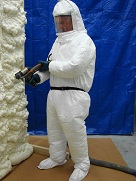 The use of appropriate protective clothing is necessary whenever there is possibility of direct contact with SPF chemicals. The appropriate protective clothing varies depending upon the potential for exposure. Applicators and helpers typically wear disposable coveralls to keep spray and mist from contacting skin and clothing. To protect skin, wear PPE in such a manner as to protect all skin (in other words, there should be no exposed skin showing). When not wearing a hood respirator, select a coverall with an attached hood or spray head cover. For tasks where there is a potential for splash, consider a suit coated with an impermeable coating such as PVC and MDI-resistant fitted boots/booties.
The use of appropriate protective clothing is necessary whenever there is possibility of direct contact with SPF chemicals. The appropriate protective clothing varies depending upon the potential for exposure. Applicators and helpers typically wear disposable coveralls to keep spray and mist from contacting skin and clothing. To protect skin, wear PPE in such a manner as to protect all skin (in other words, there should be no exposed skin showing). When not wearing a hood respirator, select a coverall with an attached hood or spray head cover. For tasks where there is a potential for splash, consider a suit coated with an impermeable coating such as PVC and MDI-resistant fitted boots/booties.
Gloves:
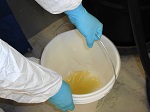 Gloves made of nitrile, neoprene, butyl or PVC generally provide adequate protection against A-side materials. (See Guidance for the Selection of Protective Clothing for MDI Users, Center for the Polyurethane Industry (CPI) Guidance Document AX178). A-side protection is generally considered adequate to provide B-side protection; however, consult the manufacturer’s SDS for specific information about B-side protection. A range of sizes should be available. A glove which is too large or small for the user may not provide proper protection. A fabric glove fully coated with nitrile, neoprene, butyl, or PVC can provide good protection for SPF applicators.
Gloves made of nitrile, neoprene, butyl or PVC generally provide adequate protection against A-side materials. (See Guidance for the Selection of Protective Clothing for MDI Users, Center for the Polyurethane Industry (CPI) Guidance Document AX178). A-side protection is generally considered adequate to provide B-side protection; however, consult the manufacturer’s SDS for specific information about B-side protection. A range of sizes should be available. A glove which is too large or small for the user may not provide proper protection. A fabric glove fully coated with nitrile, neoprene, butyl, or PVC can provide good protection for SPF applicators.
Eye and Face Protection:
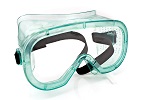 Appropriate eye protection helps prevent eye contact from splashes of liquid SPF chemicals, accidental sprays of reacting foam, aerosols and vapors that are likely to be present during spraying, and airborne particulate associated with sanding and grinding operations. The type of eye protection needed depends on the nature of the activity.
Appropriate eye protection helps prevent eye contact from splashes of liquid SPF chemicals, accidental sprays of reacting foam, aerosols and vapors that are likely to be present during spraying, and airborne particulate associated with sanding and grinding operations. The type of eye protection needed depends on the nature of the activity.
Persons handling liquid SPF chemicals in open containers can protect their eyes by wearing safety goggles or safety goggles in combination with face shields. The use of contact lenses is discouraged.
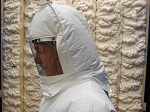 During application of SPF, eye protection may be provided by virtue of wearing a full-face or hood respirator. OSHA requires that an eyewash* or safety shower be provided in the work area where the eyes or body may be exposed to “injurious corrosive materials.” Consult the SDS for all materials to be used on the job in advance to help you understand whether such materials will be present, and if so, how to comply with applicable OSHA requirements.
During application of SPF, eye protection may be provided by virtue of wearing a full-face or hood respirator. OSHA requires that an eyewash* or safety shower be provided in the work area where the eyes or body may be exposed to “injurious corrosive materials.” Consult the SDS for all materials to be used on the job in advance to help you understand whether such materials will be present, and if so, how to comply with applicable OSHA requirements.
*OSHA references the American National Standards Institute (ANSI) “Emergency Eyewash and Shower Equipment” Standard Z358.1-1990 that was revised in 2009. The ANSI standard states an eyewash station must deliver “tepid water.” ANSI defines “tepid water” as “[a] flushing fluid temperature conducive to promoting a minimum 15 minute irrigation period.”
The ANSI Z358.1-2009 standard states, “[a] personal wash unit may be kept in the immediate vicinity of employees working in a potentially hazardous area. The main purpose of these units is to supply immediate flushing. With this accomplished, the injured individual should then proceed to a plumbed or self-contained Eyewash and flush the eyes for the required 15-minute period.” Items, like bottled eyewash, Personal Wash Units such as single head hoses, or similar supplemental equipment, may not meet the OSHA requirement and the ANSI standard’s 15 minute irrigation period.
Respiratory Protection:
Engineering controls, such as local exhaust ventilation, can be used to control SPF chemical exposures. Administrative controls, such as work schedules and work practices, are used concurrently to minimize exposure. Respirators are needed when air concentrations continue to exceed occupational exposure limits when engineering and administrative controls are implemented. These limits have been set for a number of SPF chemicals and some common chemicals encountered during SPF application.
Air-purifying respirators (APR) and powered air-purifying respirators (PAPR) are generally appropriate for exterior applications and may be used when spraying polyurethane foam in exterior applications. Supplied air respirators (SAR) are typically used in interior applications. Refer to the NIOSH Respirator Decision Logic (2004) for more information regarding respirator selection.
For more information about various types of respirators, refer to the ACC CPI Health and Safety Product Stewardship Workbook for High-Pressure Application of SPF workbook sections on:
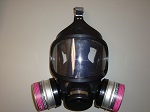 Air-Purifying Respirators (APRs): Full-face APRs may be appropriate for exterior applications of SPF. Air-purifying respirators are not appropriate in confined spaces or in atmospheres with less than 19.5% oxygen. Due to the potential for eye exposure during SPF application, full-face APRs are often selected when applying SPF. Full-face APRs may be used in the exterior application of SPF when there is sufficient oxygen (19.5-23.5%) and air concentrations of MDI are less than 0.250 parts per million (equal to 50 times the 8-hour occupational exposure limit).
Air-Purifying Respirators (APRs): Full-face APRs may be appropriate for exterior applications of SPF. Air-purifying respirators are not appropriate in confined spaces or in atmospheres with less than 19.5% oxygen. Due to the potential for eye exposure during SPF application, full-face APRs are often selected when applying SPF. Full-face APRs may be used in the exterior application of SPF when there is sufficient oxygen (19.5-23.5%) and air concentrations of MDI are less than 0.250 parts per million (equal to 50 times the 8-hour occupational exposure limit).- Powered Air-Purifying Respirators (PAPRs): Powered Air-Purifying Respirators (PAPRs) are APRs equipped with a battery-operated blower unit designed which supplies filtered breathing air to the user’s facepiece. PAPRs are often used in exterior or other applications and may be selected for use in applications where APRs are typically used for several reasons. When outdoor temperatures are hot, the PAPR can provide an air-conditioning-like effect, making the wearer cooler and more comfortable. Also, fit testing is not required for loose-fitting hood PAPR. Additionally, for medical or other reasons, some individuals may be unable to use negative-pressure APR, but can use PAPR.
 Supplied-Air Respirators (SARs): Supplied Air Respirators (SARs) are typically used in interior applications. SARs provide a supply of breathing air from an outside source such as a compressor, a bottle of compressed air, or a low pressure pump attached to an air-line hose. SARs also are called “Type C” systems or “air-line” respirators. SARs, when used properly, can provide the greatest protection for the wearer.
Supplied-Air Respirators (SARs): Supplied Air Respirators (SARs) are typically used in interior applications. SARs provide a supply of breathing air from an outside source such as a compressor, a bottle of compressed air, or a low pressure pump attached to an air-line hose. SARs also are called “Type C” systems or “air-line” respirators. SARs, when used properly, can provide the greatest protection for the wearer.
Respiratory Protection Program Requirements:
The OSHA Respiratory Protection Standard (29 CR 1910.134) requires employers to have a written respiratory protection program for employees required to use respiratory protection. The Standard outlines requirements for respirator selection, respirator maintenance, annual fit testing, medical surveillance, and annual training. Refer to your company’s policy for specific information regarding your respiratory protection program.
To assist site managers in developing their own Respiratory Protection Programs, the Center for the Polyurethanes Industry (CPI) has created Guidance for Developing a Written Respiratory Protection Program.
OSHA requires employers to provide medical evaluations administered by a physician or licensed healthcare professional for all employees required to wear respirators. Employees must receive approval prior to fit testing and subsequent issuance of the respirator. Sometimes the medical approval has a limitation such as the use being restricted to a PAPR or for emergency only. Adhere to the limitations described by the examining medical provider.
OSHA also requires that employees complete a successful fit test using a respirator of the same make, model and size respirator issued according to 29 CFR 1910.134(f). Fit testing is repeated annually thereafter. Fit testing must be completed for any employee issued a tight-fitting APR, PAPR, SAR, or self-contained breathing apparatus (SCBA). Fit testing is not required for personnel wearing a loose-fitting hood with a PAPR or SAR.
Fit testing cannot be conducted and respirators cannot be used if there is any clothing, jewelry, or hair growth between the skin and the facepiece sealing surface, such as stubble beard growth, beard, mustache or sideburns which cross the respirator sealing surface. Annual training is required under the OSHA standard for all personnel required to wear respiratory protection.
Each time the user dons a tight-fitting respirator, the user must complete a negative-pressure and positive-pressure user seal check in accordance with 29 CFR 1910.134 Appendix B-1 to confirm that the mask has been donned correctly prior to entering the work area. OSHA makes available a Small Entity Compliance Guide that contains criteria for the selection of a Respiratory Protection Program administrator and a sample program that meets OSHA requirements. It is available at: www.osha.gov/Publications/SECG_RPS/secgrev-current.pdf.
PPE for SPF High Pressure Interior Application:
When spraying an SPF two-component high pressure spray polyurethane foam system indoors, sprayers and helpers should wear:
- A NIOSH-approved full face or hood-type supplied air respirator (SAR) (as outlined in your company’s Respiratory Protection Program)
- MDI-resistant chemical gloves (e.g., nitrile), or fabric gloves coated in nitrile, neoprene, butyl, or PVC
- Chemically resistant long-sleeve coveralls or chemically resistant full body suit with hood
- MDI-resistant fitted boots/booties
PPE for SPF High Pressure Exterior Application:
When spraying an SPF two-component high pressure exterior application (e.g., roofs, tanks, top coatings), sprayers and helpers use:
- Hard hat, if needed to protect head from falling objects
- A NIOSH-approved full facepiece Air Purifying Respirator (APR) with organic vapor/particulate (P100) cartridges or a supplied air respirator (SAR), as outlined in your company’s Respiratory Protection Program.
- Safety goggles (where respirator does not cover the eyes)
- MDI-resistant chemical gloves (e.g., nitrile), or fabric gloves coated in nitrile, neoprene, butyl, or PVC
- Chemically resistant long-sleeve coveralls or chemically resistant full body suit with hood
- MDI-resistant fitted boots/booties
PPE for Non-Spraying Tasks (e.g., cleaning equipment):
For tasks that do not involve spraying (such as cleaning equipment), but where you may have direct contact with MDI liquid (at room temperature), use:
- NIOSH-approved air purifying respirator with combination organic vapor / particulate (P100) cartridges, if handling heated SPF chemicals
- Chemical safety glasses or goggles
- MDI-resistant chemical gloves (e.g., nitrile, neoprene, butyl, or PVC)
- MDI-resistant clothing (e.g., apron or coveralls)
- Safety shoes or boots
PPE for SPF Low Pressure Kits/Systems and Insulating Foam Sealant:
For information regarding PPE for two-component low pressure SPF applications, refer to the Weatherization section of the web site. For information regarding PPE for one-component insulating foam sealant, refer to the Do-It-Yourself (DIY) section of the website.
